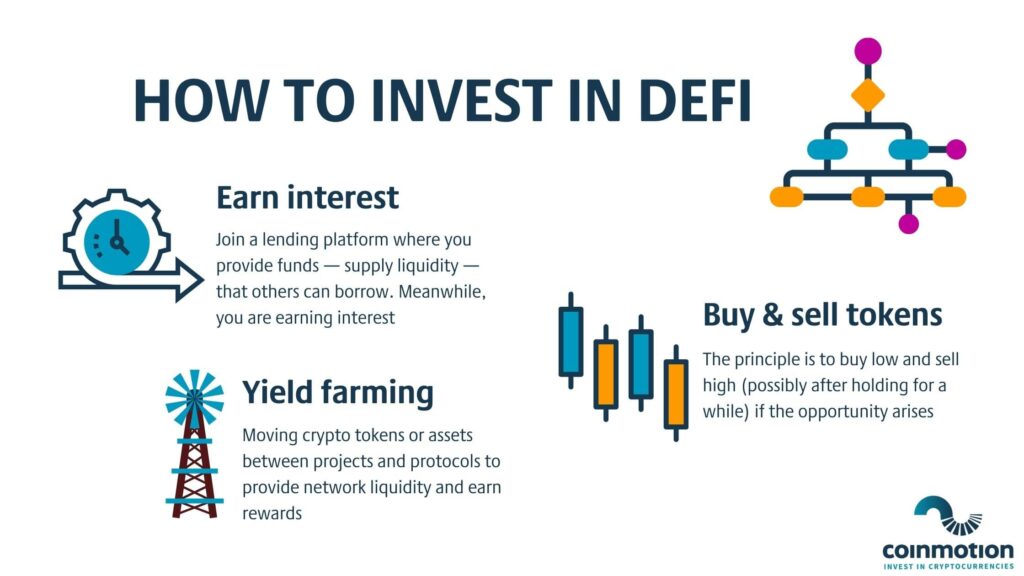Decentralized finance (DeFi) aims to solve the problems that traditional finance can’t tackle, and retail investors want to know how to hop on the trend and invest in DeFi. Before investing, it is important to know why DeFi is such a big player in the cryptocurrency industry. One should also learn what they should pay attention to when making a DeFi investment.
Why Are Investors so Interested in How to Invest in DeFi?
Decentralized finance refers to the digital, peer-to-peer applications that enable crypto trading, loans, and other services. They are the services typically associated with traditional finance but provided in an innovative way. These novel applications run on the decentralized protocols of public blockchains like Ethereum. Together, these applications create an ecosystem that bypasses conventional third parties like banks, brokers, and insurance firms.
The traditional legal bureaucracy, slow transaction speeds, human error, and outdated management systems are avoided in DeFi. DeFi works on smart contracts, which are bound to a blockchain protocol. These self-executing smart contracts improve efficiency and scalability while increasing the transparency of financial services.
The automation of smart contracts also keeps user fees and transaction costs much lower. In decentralized finance, digital assets such as Bitcoin and Ethereum replace traditional fiat currencies.
DeFi emerged as a subset of the crypto industry in 2013. Then projects like Omni (then Mastercoin) launched their first Initial coin offering (ICO). The term DeFi came about in 2018 among Ethereum developers. The new concept set the stage for a slew of decentralized financial protocols to launch on the Ethereum network the following year. In 2020, the DeFi industry was worth 13 billion EUR. That was before this industry went soaring to 100 billion EUR by the end of April 2021.
How to Invest in Defi: Important Projects to Know
Uniswap (UNI)
Uniswap is an open-source, decentralized exchange (DEX) that operates using an innovative automated liquidity protocol on the Ethereum network. Unlike centralized exchanges, Uniswap users can list tokens on the exchange for free. Users also remain in access to their private keys — giving more control over the use of funds. The lack of a central authority can help mitigate potential losses in the case of a network hack.
AAVE (AAVE)
AAVE is an Ethereum-based algorithmic money market that enables users to borrow and lend a wide variety of digital assets. Holders of AAVE tokens govern the protocol of AAVE. The AAVE algorithm allows users to initiate loans obtained from a pool. Users do that instead of needing to be individually matched to a lender. The ever-expanding platform has moved beyond money markets. The project has gained traction as a popular place for DeFi investors to acquire flash loans.
Chainlink (LINK)
Chainlink is a service that allows off-blockchain sources to provide data and information seamlessly to on-blockchain smart contracts via oracles. Oracles help to maintain the integrity of the network when moving secure data onto the blockchain. The security hardware and protocol ensure reliability and lessen the potential for human or system error. In other words, what often occurs when using a centralized source is not prevalent in DeFi.
More DeFi Names to Know
The DeFi ecosystem has a variety of market options for every type of service. Uniswap competes alongside DEX aggregator 1INCH and Pancakeswap (CAKE), while Maker (MKR) and Compound (COMP) provide loan services similar to AAVE. Protocols like Tezos (XTZ) focus on a user-governed execution of smart contracts. That’s what places Tezos in the same sphere as DeFi projects like Chainlink.

How Do You Invest in DeFi
Trading & Acquiring Defi Tokens
Purchasing DeFi assets for both long and short-term holds is one of the primary ways to invest in this industry. The principle here is usually to buy low and sell high if the opportunity to do so arises. Using decentralized exchanges like Uniswap, users can scout project tokens with growth potential or invest in established protocols.
Yield Farming
Yield farming is a popular way to use decentralized finance as a way to earn passive income. It involves moving different crypto tokens or assets between projects and protocols to provide network liquidity in exchange for incentives. The goal is to move between protocols with the best rates to earn the highest yield in a liquidity pool.
Earning Interest Through Liquidity Protocols
DeFi gives a lot of interesting ways to earn passive income. Lending protocols, like AAVE, are decentralized loan platforms that give borrowers and depositors the ability to interact with each other. In this relationship, depositors supply liquidity for the sake of earning interest rates. Meanwhile, borrowers take loans from the liquidity provided.
How to Invest in Defi: What to Pay Attention to
With so many DeFi projects running in the ecosystem, it can be dizzying trying to figure out which investment opportunities to pursue in blockchain and cryptocurrency. Here are a few simple principles to guide you when considering your options in the DeFi market.
User Adoption
For starters, you should begin by looking at the number of active users of a given blockchain or project. The user adoption trend over time will provide clear insight into how the project is expanding and the likelihood of a return on investment. This is because the inherent value of a blockchain is based on its usership and its potential to grow, expand and adapt.
That said, robust growth at the launch of a project says very little about the project’s ability to sustain growth. Rapid growth spurred by a market frenzy can lead to plateaus in adoption that are hard to overcome. Conversely, projects with a history of exponential growth suggest that the project has the potential to be a viable investment in the future.
Market Need
Another key consideration is to invest in the protocols and projects that fulfill a need in the DeFi ecosystem. This means doing a bit of research about the industry and investing in platforms that have a strong likelihood to be adopted and that provide innovation to the market.
Think Long Term
With successfully expanding projects, resisting the urge to move your crypto assets between protocols and platforms, or yield farming, might help you reap the most reward. Holding governance tokens in these projects also gives you the right to vote in matters concerning the project’s development.
Is it Understandable?
Investing in projects that fulfill a need means very little if you cannot understand what exactly it does. The chances that a new project will be successful are directly related to the ability of new users to understand it. When choosing projects to invest in, favor those with clear white papers and easy-to-follow road maps. If you cannot understand what the project is trying to do, the higher the likelihood that others do not either.
How to Invest in Defi: What are the Risks
In the case of DeFi, its greatest asset — decentralization — warrants its own reserves. The new and developing protocols and projects, coupled with the lack of a central authority, increase the usual risks associated with a crypto investment.
Staking tokens in DeFi often requires users to lock their staked funds for a given period. Meanwhile, market fluctuations and other changes can cause crypto prices to rise or fall in real-time — without giving the holder the ability to sell. Though rare, smart contracts have the potential to execute incorrectly following a faulty blockchain protocol affecting staked funds or a payout.
How to invest in DeFi on Coinmotion
Overall, the continued growth and interest in DeFi suggests its importance to the market — good news for those eager to invest. You can buy the tokens of the most promising DeFi projects on Coinmotion: Aave, Uniswap, and Chainlink. You can also invest in Ethereum, which powers the DeFi ecosystem. To start, click here.
